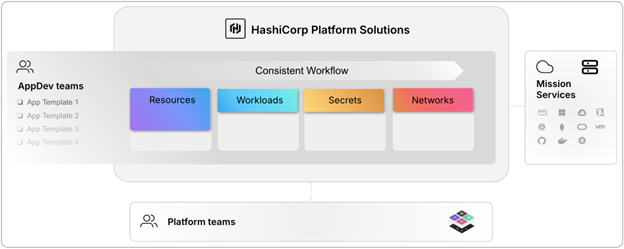Cloud Organizational Readiness in a Change-Hesitant Climate

From IC Insider HashiCorp
By Ieshia Smith
By 2028, Gartner predicts that cloud computing will evolve from a technology disruptor and capability enabler to a business necessity. DoD and IC agencies utilize cloud-based technologies to deliver scalable, flexible, and cost-effective solutions for their mission. The cloud – whether public, private, or hybrid – provides IT services on-demand over the Internet, reducing the capital complexity exhibited by traditional on-premises data center operations. Since the meteoric rise of cloud providers in the early 00s, agencies have made significant investments in developing practices to capitalize on the possibilities afforded by the modern era of technological advancements. In embarking on a cloud adoption journey whereby agencies shift resources from on-premises to cloud-based destinations, the DoD and IC communities must contend with critical internal factors that impact mission success.
An IT transformation, no matter the scale, simultaneously operates on the business and technology dimensions. The cloud offers the opportunity for streamlined value realization and enhanced agility, yet agencies need to balance the desire to revolutionize operations with the reality of the human condition. Change within an agency fundamentally challenges an employee’s perception of their role within their division. McKinsey estimates that 70% of transformations fail in part due to misalignment between the organizational vision and the employee experience. To circumvent the fear, uncertainty, and doubt endemic of large-scale IT transformations, it is imperative that agency leaders proactively drive positive outcomes for employees navigating the changing landscape. Leaders should adopt a human-first framework throughout the stages of adoption and ensure that the employee voice has an empowered seat at the stakeholder table. A measured approach to define the fundamentals of the change – aligned to tangible outcomes for both the mission and workforce – helps agencies to navigate the complexities of the hybrid cloud adoption while keeping the employee experience in the foreground.
Establish the North Star – Communicating Change
The 5WH1 (who, what, where, when, why, how) framework provides a critical lens through which people analyze information available to them. An innate desire for understanding drives a need to seek answers and make decisions based on an individual’s evaluation criteria. If a person determines the details before them align with their definition of valuable, they are likely to proceed forward. However in the inverse, they may challenge the requestor that placed an unclear or unreasonable request on them, seeking further clarification before making a decision. For mission delivery, the onus rests on the agency to provide employees with the necessary qualification criteria to carry out tasks and strategic directives. People are the core of IT transformations; it is tantamount to ensure employees are equipped with information vital to the success of the mission.
For hybrid cloud adoption, an agency commits to shifting a portion of its technology stack across one or more cloud ecosystems over a period of time. Employees need to understand the rationale and expected outcomes for cloud adoption and leaders must communicate often and clearly with the workforce throughout the process. For agencies with significant legacy footprints and long-tenured employees, it is especially important to articulate the vision and impact that a large-scale transformation will have on day-to-day operations and the overall mission. Using the basics of the 5W1H framework, agency leaders can distill the mission’s trajectory into simple questions and create an initial communication plan for all affected organizational units. Consider:
- Who is impacted and who is responsible for the outcome of the cloud migration?
- What is the agency addressing with the cloud migration?
- To which cloud providers will the agency migrate?
- Why is the agency moving now or at all to the cloud?
- When will the cloud migration begin and end?
- How will the agency support technical and non-technical teams throughout the cloud migration?
The answer to each question should align the agency’s current reality with measurable benefits post-migration. By socializing the objectives and expected outcomes of the migration with the workforce, an agency can foster a culture of understanding and awareness of critical mission decisions.

HashiCorp’s approach to contextualizing the enterprise adoption of cloud – called the Cloud Operating Model – provides agencies with industry best practices for hybrid cloud adoption, including how to enable the workforce for an evolution in technology operations. The Cloud Operating Model offers a phased approach towards cloud maturity from initial adoption to deploying across multiple providers. The tenets of the Cloud Operating Model outline a repeatable and scalable methodology that drives change and empowers people as agencies adopt, standardize, and scale in the cloud. Aligning workforce wellness with mission-oriented outcomes such as security, efficiency, and standardization enables agencies to accelerate delivery, provide innovative capabilities, and lower risk. As an agency’s cloud strategy evolves over time, leaders within the agency should continually refine communications to ensure employees understand how they can continue to develop as professionals while delivering on the mission.
Leverage the Good, Repair the Broken, Build the Missing
Hybrid cloud adoption opens a window to revamp the present state of operations and shepherd in value-add opportunities for an agency. As part of due diligence when preparing the workforce for a cloud journey, examine the effectiveness of existing processes and tools to determine the net impact of keeping, modifying, or retiring them as part of the cloud roadmap. Embarking on a transformational journey does not inherently negate the value of what has come before. An agency may inadvertently spark employee resistance to change by decommissioning functional or well-known processes without considering the immediate impact on affected personnel. The hybrid cloud journey is contextual to the present mission reality; employees settle into a familiar rhythm and notice any ripple across a smooth surface. When analyzing an IT portfolio and operations for cloud suitability, an agency should examine whether the function merits continuation into the future, and if not, define and disseminate a plan for revitalization or retirement. If the plan is to introduce new capabilities that complement existing ones, ensure that employee stakeholders understand the upside benefit to their specific role resulting from the planned change.
Investments in new technologies and processes warrant significant financial and material commitments. Within an agency, employees exist within a space that requires their compliance yet cannot command their acceptance. It is the responsibility of the agency to minimize the amount of superfluous interruptions to the employee experience that detract from professional well-being. Cloud journeys introduce complexity, heightened demands, and unfamiliar technologies while simultaneously requiring employees to maintain day-to-day operations prior to full cutover. A well-defined and socialized cloud strategy mitigates the operational impact to the employee.

To assist employees with the smooth transition to a cloud ecosystem, agencies should leverage existing agnostic or cross-functional investments when possible and build out universal workflows that translate across multiple ecosystems. HashiCorp Platform Solutions allow agency departments to standardize on one methodology that translates across multiple cloud and on-premises systems. Instead of requiring teams to learn the intricacies of each onboarded solution and creating an individual approach to cloud provider management, HashiCorp enables employees to utilize a single workflow to manage the IT lifecycle. By establishing a golden workflow for organizational units to follow, agencies preemptively alleviate the challenge of operating across disparate providers while enabling the flexibility to scale as needed. The golden workflow reduces the technical knowledge burden for employees as HashiCorp abstracts the complexities of vendor-specific API management with a simplified configuration language. Employees can utilize existing skill sets and best practice management of current systems while the agency progresses along the cloud adoption maturity curve. As the mission requires the introduction of additional solutions, combine lessons learned throughout the journey into a repeatable workflow to facilitate a streamlined onboarding process. By establishing a uniform platform approach to solution delivery, agencies will minimize IT disruptions and increase operational functionality as departments execute on the future mission vision.
Teach the Workforce to Fish
A 2022 GAO study uncovered opportunities for the DoD to improve workforce planning during technology modernization initiatives. The GAO detailed nine recommendations to address gaps in cloud workforce readiness, including skill assessments, customer experience evaluation, communication plans for planned changes, and IT portfolio management improvement. In Sept 2023, the DoD completed a gap analysis to anticipate and address skill and role requirements for enterprise cloud adoption. As agencies look forward to incorporating additional solutions under their IT umbrellas, the technology landscape continually evolves and departmental leaders need to enable their workforce to stay ahead of the latest innovations. The rise in popularity of capabilities such as infrastructure-as-code, DevSecOps, containerization, and AI/ML further exacerbated the need for skilled, proficient workers – leading agencies to restructure previously established workforce enablement and training programs. Delivering results in a cost and time-effective manner, increasing the security posture, and reducing risk from malicious actors drives agencies to consider how to enable employees to deliver on mission needs with the arsenal of available capabilities on the market. When an agency undertakes a cloud adoption or IT modernization effort, the question of how to reskill and upskill the workforce begs deeper consideration. Even with a clearly defined communication structure and process roadmap, an agency must empower employees with the expertise to operate throughout the lifecycle of cloud technologies.
Employees rarely begin the learning journey with a blank slate. An agency should identify the delta in existing skills across key personas and determine the desired skills needed as cloud adoption progresses. Look internally for opportunities to enhance transferable skills and nurture in-house talent. Providing employees with flexible self-guided and classroom-based learning options enables them to learn at a comfortable pace in collaboration with peers. While collecting provider or competency-specific certifications can offer a framework for the upskilling process, an agency should promote an open culture and way of thought that promotes innovation, measured risk-taking, and individual creativity. Fostering a positive learning environment where employees have room to fail and succeed in a safe space will translate to a cloud-smart workforce that understands and executes on the communicated hybrid cloud adoption strategy.

Cloud technology providers like HashiCorp offer free, virtual training available on-demand for convenient learning opportunities for infrastructure or security competencies. In addition to course-based learning, HashiCorp publishes step-by-step, hands-on learning labs to enable use case-specific opportunities for immersion across the cloud stack. Supplemental learning in conjunction with agency-sponsored courses allows employees to tailor their educational experiences according to their specific role persona and professional areas of interest. The learning modules provided by HashiCorp promote a deeper understanding of foundational principles of cloud operations, facilitating the application of theoretical knowledge to practical scenarios in real-world cloud environments.
Conclusion
Change is an inevitability in the mission and how agencies empower their employees to respond to change can make or break a cloud journey. Begin with clear and consistent communication early in the process and encourage open employee dialogue throughout the journey. By evaluating existing processes and tools, an agency can ensure that valuable practices are retained while introducing new practices with minimal disruption. Building a culture of learning encourages innovation and adaptability, essential for navigating the complexities of cloud technology. As the needs and requirements of the mission progress, leverage industry partners like HashiCorp to work in tandem with agency departments and enable rapid transformation, advance cloud maturity, and accelerate value-based delivery. Ultimately, agencies that prioritize the employee experience alongside technological transformation will achieve more effective, successful, and sustainable mission outcomes.
About HashiCorp
HashiCorp is the leader in multi-cloud infrastructure automation software. The HashiCorp software suite enables organizations to adopt consistent workflows to provision, secure, connect, and run any infrastructure for any application. HashiCorp open source tools Vagrant, Packer, Terraform, Vault, Consul, and Nomad are downloaded tens of millions of times each year and are broadly adopted by the Global 2000. Enterprise versions of these products enhance the open source tools with features that promote collaboration, operations, governance, and multi-data center functionality. The company is headquartered in San Francisco and backed by Mayfield, GGV Capital, Redpoint Ventures, True Ventures, IVP, and Bessemer Venture Partners. For more information, visit www.hashicorp.com or follow HashiCorp on Twitter @HashiCorp.
About IC Insiders
IC Insiders is a special sponsored feature that provides deep-dive analysis, interviews with IC leaders, perspective from industry experts, and more. Learn how your company can become an IC Insider.








